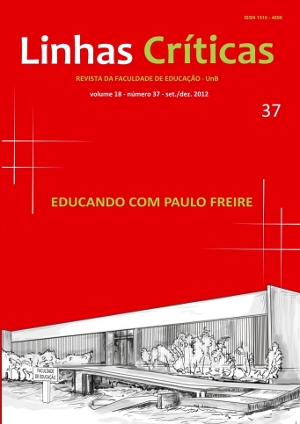Youth as a stigmatizing condition: relations between inequality, violence and experience in school
DOI:
https://doi.org/10.26512/lc.v18i37.4028Keywords:
Youth, Stigmatization, ViolenceAbstract
Considering that, at their limit, stigmatization and exclusion become processes of self exclusion, through the strength of unconscious mechanisms of symbolic domination, it becomes imperious to evidence the points of view of youth. Today, one perceives a dual discourse about adolescents and youth: they are the promise of the future and, at the same time, violent criminals who threaten “social tranquility”. This paper, therefore, intends to contribute to enable an analytic change in the field of research about violence in schools, far removed from the hegemonic approaches characteristic to penal common sense and biologistic racism. The term “violence”, in socio educational research, takes on diverse meanings, including contradictory ones - several of which partly incorporate meanings which stem from common sense and supposed hegemonic paradigms. Changing the vision that tends to impose itself as a truth is treated in this article as a challenge and a utopia.
Downloads
References
BOURDIEU, Pierre. (1987). Cosas dichas. Barcelona, Gedisa, 2000.
ELIAS, Norbert. El proceso de la civilización. Investigaciones sociogenéticas y psicogenéticas. Madrid, Fondo de Cultura Económica, 1993.
ELIAS, Norbert. La sociedad de los individuos. Barcelona, Península, 2000.
GOFFMAN, Ervin. Estigma. La identidad deteriorada. Buenos Aires, Amorrortu, 1989.
KAPLAN, Carina Viviana. Talentos, dones e inteligencias. El fracaso escolar no es un destino. Buenos Aires, Colihue, 2008.
_______. La confianza hacia las posibilidades de aprender de los alumnos: un umbral necesario para abordar la diversidad sociocultural en la escuela. In: Vergara Fregoso, Martha y Alegría Ríos Gil, Josefa (Coords.): La diversidad cultural: retos y perspectivas para su atención educativa - Argentina, Colombia, Guatemala, México y Perú. Jalisco, México: Editorial Universidad de Guadalajara, 2010, p. 93-112.
_______. Jóvenes en turbulencia. Miradas críticas contra la criminalización de los estudiantes. In: Revista Propuesta Educativa. Buenos Aires, FLACSO, Nº 35, 2011a Disponível em: <http://www.propuestaeducativa.flacso.org.ar/articulo.php?id=26&num=35>. Acessoem: 12 nov. 2011a.
_______. La sensibilidad por la violencia como experiencia cultural y educativa en sociedades de desigualdad. El caso de losjóvenes. Caderno de Estudos Sociais.Recife, Fundação Joaquim Nabuco, vol. 25, n. 1, p. 45-52, jan./jun. 2011b.
MUCHEMBLED, Robert. Una historia de la violencia. Del final de la Edad Media a la actualidad. Buenos Aires, Paidós, 2010.
WATERS, Cas. La civilización de las emociones: Formalización e informalización. In: Kaplan, Carina Viviana (coord.). La civilización en cuestión. Escritos inspirados en la obra de Norbert Elias. Buenos Aires, Miño y Dávila, 2008.
VALLES, Miguel. Técnicas cualitativas de investigación social. Madrid, Síntesis Sociología, 1997.
WIEVIORKA, Michel. Racismo. Una introducción. Barcelona, Gedisa, 2009.
Downloads
Published
How to Cite
Issue
Section
License
Copyright (c) 2016 Linhas Críticas

This work is licensed under a Creative Commons Attribution 4.0 International License.
Authors who publish in this journal agree to the following terms:
-Authors maintains the copyright and grants the journal the right of first publication, the work being simultaneously licensed under the Creative Commons Attribution License which allows the sharing of the work with recognition of the authorship of the work and initial publication in this journal.
- Authors are authorized to enter into additional contracts separately, for non-exclusive distribution of the version of the work published in this journal (eg publish in institutional repository or as a book chapter), with acknowledgment of authorship and initial publication in this journal.
-Authorers are allowed and encouraged to publish and distribute their work online (eg in institutional repositories or on their personal page) at any point before or during the editorial process, as this can generate productive changes as well as increase the impact and the citation of published work (See The Effect of Free Access).



